#Suor Plautilla Nelli
Explore tagged Tumblr posts
Text

👩🏻🎨 artists profile.
Sister Plautilla Nelli
aka Suor Plautilla
1524 - 1588
Nelli is the first known female Renaissance painter of Florence. She was born to a wealthy Florentine family and joined the Dominican convent of Santa Caterina di Cafaggio when she was 14. Nelli changed her name to Suor Plautilla. This is where she was learned art.
The convent was managed by the Dominican friars of San Marco who were lead at the time by Savonarola who was also a prophet. He encouraged the nuns to learn an art to prevent sloth, this turned the convent into a center of art. Nelli chose painting. She had a sister who chose writing.
The most famous of the sisters, Nelli taught herself how to paint and draw by studying other artists. She learned from artists like Angelo Bronzino, Andrea del Sarto, but her main influence was Fra Bartolomeo. Most of Nelli’s art was large and more expressive than the men she learned from. She signed her work “pray for the paintress”.
Plautilla Nelli was mentioned in Vasari’s book Lives of the Most Exellent Painters, Sculptors, and Architects.

Sourced from Wikipedia
#female artist#female artists#Italian art#Italian history#art history#renaissance art#religious art#women in art#Plautilla Nelli#suor Plautilla#sister Plautilla#catholic art
2 notes
·
View notes
Text

Sister Plautilla Nelli, Madonna, Child and 4 Angels,
Pulisena Margherita was born into the Florentine Nelli family in the year 1524 she was baptized on January 29, 1525. Via Wikipedia in Italian
Sister Plautilla Nelli (1524–1588) was a self-taught nun-artist and the first ever known female Renaissance painter of Florence. She was a nun of the Dominican convent of St. Catherine of Siena located in Piazza San Marco, Florence. Via Wikipedia ENG


#Suor Plautilla Nelli madonna bambino e 4 angeli#Sister Plautilla Nelli#sour Plautilla Nelli#Plautilla Nelli#Pulisena Margherita Nelli
1 note
·
View note
Photo








My first thought was: how sad. What fate could be worse than to be in close proximity to genius, capable of recognizing it, but, alas, something less-than? And [she] must have been less-than, because I’d barely heard of her. How terrible, and sadly typical, that in my long pursuit of women artists I’d apparently learned nothing. Least of all, that they are all too easily lost to time, a condition rarely any reflection on their talent.
- Bridget Quinn, Broad Strokes: 15 Women Who Made Art and Made History (In That Order)
Plautilla Nelli, Suor Plautilla Nelli (1524-88)
Self Portrait, Sofonisba Anguissola (1554)
Irene di Spilimbergo, Titian and Gian Paolo Pace (c. 1560)
Self Portrait with Madrigal, Marietta Robusti (c. 1578)
Self Portrait in a Studio, Lavinia Fontana (1579)
Judith with Head of Holofernes, Fede Galizia (1596)
Self Portrait as Allegory of Painting (La Pittura), Artemisia Gentileschi (c. 1638-9)
Self Portrait as Allegory of Painting, Elisabetta Sirani (1658)
i. ii. iii. iv. v. vi. vii. viii.
#plautilla nelli#suor plautilla nelli#sofonisba anguissola#irene di spilimbergo#marietta robusti#lavinia fontana#fede galizia#artemisia gentileschi#elisabetta sirani#women artists#art history#historical women#history#european history#women#i will never be over it#am firmly staying on my bullshit when it comes to women artists#i have so many emotions#baroque#renaissance
78 notes
·
View notes
Text

Suor Plautilla Nelli, Annunciation. 16th century. Oil on wood. Uffizi Gallery, Florence.
#suor plautilla nelli#16th century#woman artist#women artists#nun artists#female painter#italian artist#annunciation#art history#history of art#early modern
8 notes
·
View notes
Text
Le parole dell'amore. Ritratti di donne
Le parole dell’amore. Ritratti di donne
San Casciano in Val di Pesa, Firenze – Festa della Toscana 2021 Biblioteca Comunale, sabato 7 maggio 2022, ore 18 San Casciano in Val di Pesa, Firenze – La conferenza performance ideata e curata da Giovanna M. Carli per esprimere con forza il no ai linguaggi d’odio, in occasione della Festa della Toscana 2021, sarà presentata sabato 7 maggio 2022 alle ore 18.L’evento, organizzato dalla…
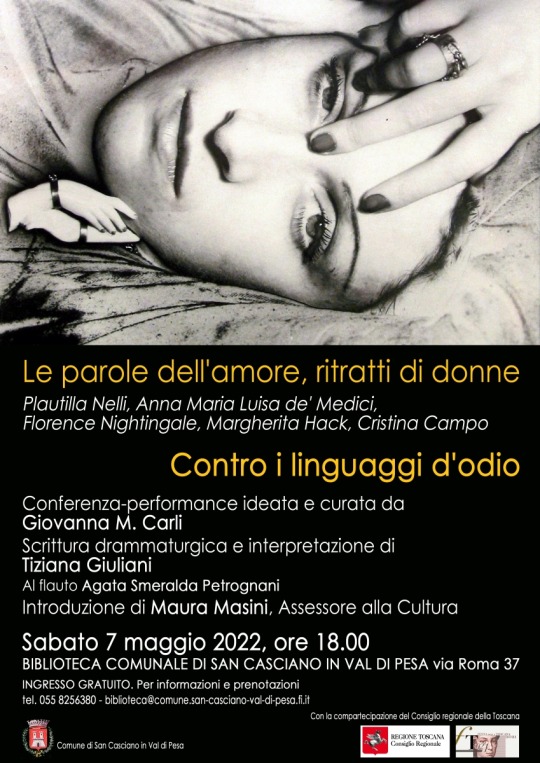
View On WordPress
#Agata Smeralda Petrognani#Anna Maria Luisa de&039; Medici#Biblioteca comunale di San Casciano in Val di Pesa#Consiglio regionale della Toscana#Contro i linguaggi d&039;odio#Cristina Campo#Festa della Toscana#Florence Nightingale#Giorgia Frosecchi#Giovanna M. Carli#Margherita Hack#Martina Ciani#Martina Ricci#Maura Masini#Parole d&039;amore#Ritratti di donne#Suor Plautilla Nelli#Tiziana Giuliani
1 note
·
View note
Photo




Sister Plautilla Nelli (1524–1588) was a self-taught nun-artist and the first known female Renaissance painter of Florence. She was a nun of the Dominican convent of St. Catherine of Siena located in Piazza San Marco, Florence, and was heavily influenced by the teachings of Savonarola and by the artwork of Fra Bartolomeo.
Life
Pulisena Margherita Nelli was born into a wealthy family in the San Felice area of Florence. Her father, Piero di Luca Nelli, was a successful fabric merchant and her ancestors originated from the Tuscan valley area of Mugello , as did the Medici dynasty . There is a modern-day street in Florence, Via del Canto de' Nelli, in the San Lorenzo district, named for her family, and the New Sacristy of the Church of San Lorenzo is the original site of her family homes.
She became a nun at the age of fourteen, taking on the name Suor Plautilla, at the convent of Santa Caterina di Cafaggio; she would later be prioress on three occasions. The facility was managed by the Dominican friars of San Marco, led by Savonarola. About half of all educated girls in that era were placed into convents to avoid the cost of raising a dowry. Savonarola's preachings promoted devotional painting and drawing by religious women to avoid sloth, thus the convent became a center for nun-artists. Her sister, also a nun, Costanza, (Suor Petronilla) wrote a life of Savonarola.
Nelli had the favor of many patrons (including women), executing large pieces and miniatures. Sixteenth-century art historian Giorgio Vasari wrote, "and in the houses of gentlemen throughout Florence, there are so many pictures, that it would be tedious to attempt to speak of them all." Fra' Serafino Razzi, a sixteenth-century Dominican Friar, historian and Savonaroliano (disciple of Savonarola), named three nuns of Santa Caterina as disciples of Plautilla, Suor Prudenza Cambi, Suor Agata Trabalesi, Suor Maria Ruggieri, and three others as additional producers: Suor Veronica, Suor Dionisia Niccolini, and his sister Suor Maria Angelica Razzi.
Art and style
Though she was self-taught, she copied works of the mannerist painter Agnolo Bronzino and high Renaissance painter Andrea del Sarto . Her primary source of inspiration came from copying works of Fra Bartolomeo , which mirrored the classicism -style enforced by Savonarola's artistic theories. Fra Bartolomeo left his drawings to his pupil, Fra Paolino who, in turn left them in the possession of "a nun who paints" in the convent of Santa Caterina da Siena. Nelli signed her paintings as "Pray for the Paintress" after her name, confirming her role in spite of her gender. Her work is distinguished from that of her influencers by the heightened sentiment she added to each of her characters' expressions. Author Jane Fortune referred to her Lamentation with Saints and the "raw emotional grief surrounding Christ's death as depicted through the red eyes and visible tears of its female figures" as a case in point. Nelli's Lamentation, which is now in the Museum of San Marco, Florence, has also spurred the writings of The Painter-Prioress of Renaissance Florence, written by Jonathan K. Nelson. Most of Nelli's works are large-scale, which was most uncommon for a woman to paint, in her era.
She is one of the few female artists mentioned in Vasari's Lives of the Most Excellent Painters, Sculptors, and Architects. Her work is characterized by religious themes, with vivid portrayals of emotion on her characters' faces. Nelli lacked any formal training and her male figures are said to have “feminine characteristics”, as her religious vocation prohibited study of the nude male.
Works created, rediscovered, and restored
DocumentaryThe Restoration of Lamentation with Saints: Plautilla Nelli is a thirty-six-minute documentary on the life of Nelli and on the process of restoring of one of her most significant large-scale paintings. The documentary, produced in 2007 by Art Media Studio, Florence, was developed and funded by The Advancing Women Artists Foundation's founder Jane Fortune and The Florence Committee of the National Museum of Women in the Arts.The documentary explores the preparatory drawings beneath the painting's pictorial surface using the process of reflectography. It shows various steps of the restoration project safeguarding the painting against woodworms, found in the painting's wood panel and exterminated, and centuries of encrusted dust and dirt. The documentary's main protagonists include museum executives and art conservation experts such as the San Marco Museum director Dr. Magnolia Scudieri and Florentine restorer Rossella Lari. The restored painting was completed in October 2006, and unveiled at Florence's San Marco Museum where it is exhibited in the large refectory. In her closing comment, Scudieri states, "Not only can we more clearly see the painting's expressive intensity thanks to this restoration, we can also more fully understand the convent life of Plautilla Nelli and her time in Florence.
PBS television documentaryThe Emmy-winning PBS television documentary (June, 2013) Invisible Women, Forgotten Artists of Florence, based on Dr. Jane Fortune's book by the same title, features a segment on Suor Plautilla Nelli and the restoration of the Lamentation with Saints. The television special, which spotlights the thousands of works by women in storage in Florence's museums, hails the little-known nun-painter as "the first woman artist of Florence."
https://en.wikipedia.org/wiki/Plautilla_Nelli
3 notes
·
View notes
Text
Punto VIII-Eva e le Monache- Tutte le Eva del mondo
Punto VIII-Eva e le Monache- Tutte le Eva del mondo


L’ultima cena di Suor Plautilla Nelli
Sapete perché molte donne preferivano i voti alla vita matrimoniale nel Medioevo e nel Rinascimento?
Cari miei l’intelligenza femminile a quei tempi era soggetta al patriarcato, prima dei padri poi dei mariti, mentre entrare in convento era una liberazione a questa priorità.
Molte donne là dentro, chiuse tra quattro mura votate alla castità…
View On WordPress
0 notes
Photo

Plautilla Nelli, Pained Madonna, c. 16th century Suor Plautilla Nelli was the first known female Renaissance painter in Florence, Italy.
#Plautilla Nelli#womens art#art#painting#religious art#16th century art#late renaissance#women's art#history
13 notes
·
View notes
Text
ARTE RENACENTISTA
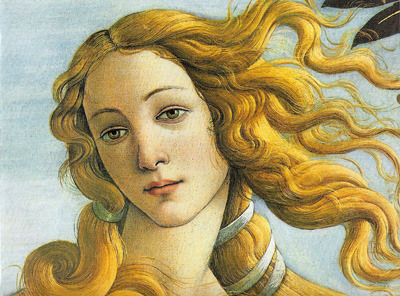
El renacimiento en Europa no fue un sitio prometedor precisamente para las artistas emergentes. De las mujeres se esperaba que se casasen y tuviesen hijos, y aquellas que trabajaban no eran bienvenidas a las profesiones dominadas por hombres. De hecho, las mujeres no podían recibir información en las artes.
Pero algunas consiguieron emerger. Gracias a las enseñanzas privadas, generalmente dadas por los padres que las estaban guiando dentro del negocio, eran suficientemente talentosas como para ganar comisiones por sus propios medios, algunas mujeres consiguieron hacer sus vidas como artistas.
A continuación pasamos a conocer algunas artistas que despuntaron en su tiempo.
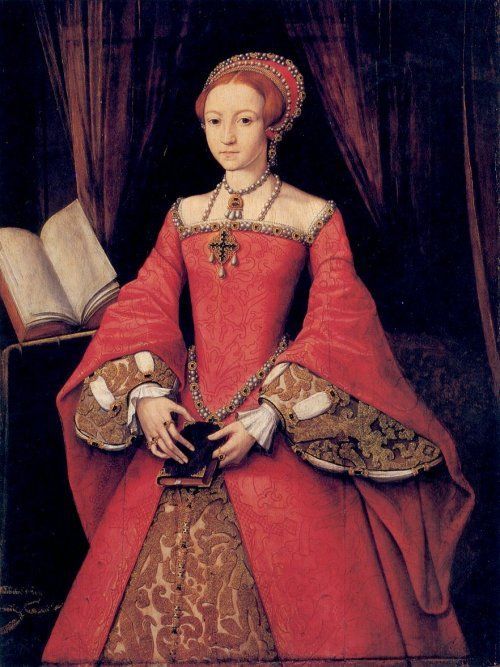
Levina Teerlinc
Pintora flamenca (ca.1510-1576) que trabajó como pintora en la corte inglesa de Enrique VIII, Eduardo VI, María I y Elizabeth I. Fue la miniaturista más importante en la corte inglesa entre Hans Holbein el Joven y Nicholas Hilliard. Su padre, Simon Bening era un famoso iluminador de libros y pintor en miniatura de la escuela de Gante-Brujas y probablemente la formó como pintora de manuscritos. Pudo haber trabajado en el taller de su padre antes de su matrimonio.
Poco se sabe acerca de su carrera o entrenamiento tempranos, pero en 1545 fue invitada a la corte de Enrique VIII, que había sido el patrón de Hans Holbein y Lucas Horenbout (quienes habían fallecido recientemente), y fue nombrada “dolorosa” real. Después de la muerte de Henry, ella continuó en este papel bajo la reina Mary I y la reina Elizabeth I.
Limitó su producción a las miniaturas de retratos, que son recuerdos personales que tienden a dispersarse ampliamente y no se muestran formalmente como lo son las pinturas de tamaño completo. Como resultado, ella es menos conocida que sus predecesoras y es más difícil atribuir sus obras con autoridad. De hecho, a pesar del hecho de que se sabe que ella pintó a muchos miembros de la corte, solo hay un puñado de obras que se le atribuyen y ninguna que definitivamente se sabe que está en sus manos.
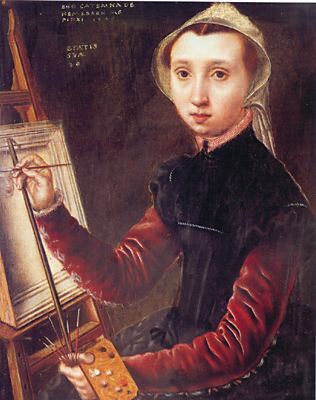
Caterina van Hemessen
Pintora flamenca 1527-1587. Fue miembro del Gremio de San Lucas e incluso se convirtió en maestra de tres estudiantes varones. El patrón principal de Caterina fue María de Austria (Regente de los Países Bajos). Cuando María renunció a su puesto en 1556 y regresó a España, Caterina y su esposo fueron invitados a unirse a ella. María les dio fondos, permitiéndoles vivir el resto de sus vidas cómodamente.
Caterina van Hemessen era la hija del pintor manierista Jan Sanders van Hemessen. Fue entrenada por éste e incluso colaboró con él en algunas de sus pinturas.
Trabajó en retratos, pintando hombres y mujeres adinerados, generalmente sobre un fondo oscuro. y si bien creó al menos dos pinturas religiosas, fue principalmente una retratista. Ocho pequeños retratos y dos cuadros religiosos, con fechas entre 1548 y 1552, que llevan su firma, han sobrevivido. Retrató a hombres y mujeres ostensiblemente ricos posados a menudo contra un fondo oscuro. Las delicadas figuras que pintó tienen un encanto elegante y están provistas de elegantes trajes y accesorios.
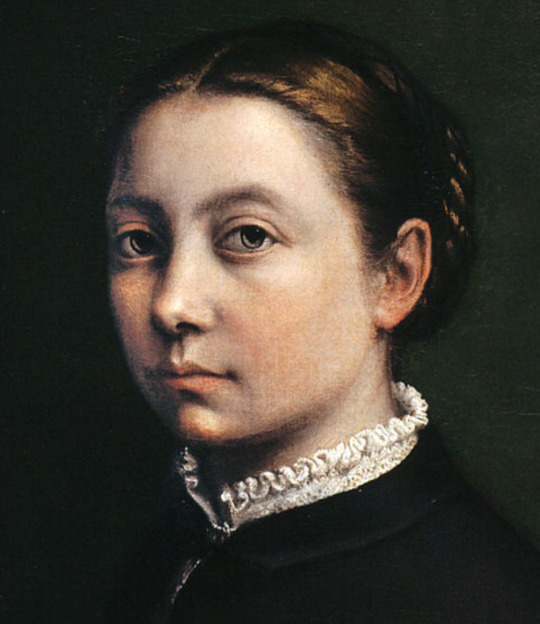
Sofonisba Anguissola
Pintora italiana, 1532-1625. Sofonisba Anguissola fue la mayor de siete hijos en una familia aristocrática. En 1554 viajó a Roma y conoció a Miguel Ángel, quien reconoció su talento. Miguel Ángel incluso le envió algunos de sus propios dibujos para que ella los copiara y le enviara para que los critique.
Su padre se aseguró de que Sofonisba y sus hermanas fueran educadas en bellas artes. Sofonisba fue aprendiz de Bernardino Gatti. A la edad de 14 años su padre la envió, junto con su hermana Elena, a estudiar con Bernardino Campi, pintor también nacido en Cremona, un respetado autor de retratos y escenas religiosas de la escuela de Lombardía. Cuando Campi se mudó a otra ciudad, Sofonisba continuó sus estudios con el pintor Bernardino Gatti (conocido como «El Sojaro»).
Un total de 50 obras han sido atribuidas con seguridad a Sofonisba. Sus cuadros pueden ser vistos en las galerías en Bérgamo, Budapest, Madrid (Museo del Prado), Milán (Pinacoteca de Brera), Nápoles, Siena y Florencia (Galería Uffizi). Su obra ha tenido enorme influencia en las generaciones de artistas posteriores. Su retrato de la reina Isabel de Valois con una piel de marta cibelina fue el retrato más copiado en España. Entre estos copistas se incluyen muchos de los mejores artistas del momento, como Pedro Pablo Rubens.
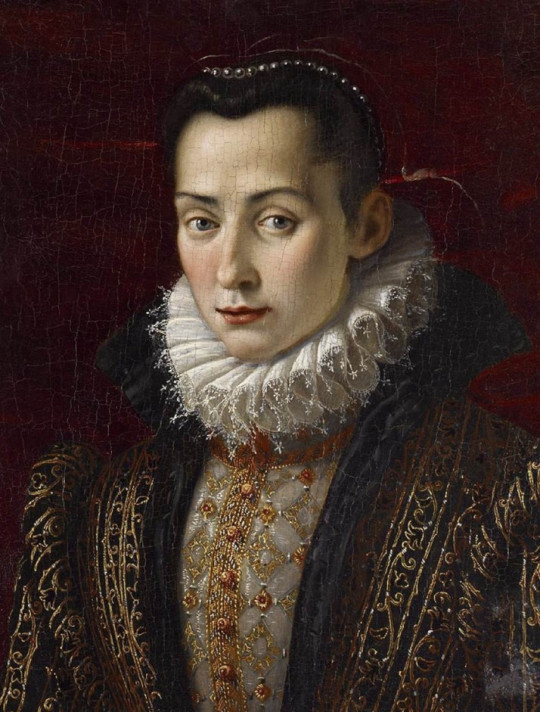
Pintora italiana, 1552-1614. Lavinia Fontana era hija del pintor de la Escuela de Bolonia, Prospero Fontana, quien formó a Lavinia en pintura. El estilo de Fontana fue, efectivamente, muy cercano al manierismo tardío que practicaba su padre. Ya desde muy joven se hizo un nombre como pintora de pequeñas obras de gabinete, principalmente retratos.
La mayoría de las mujeres que en esta época se dedicaron a la pintura, aprendieron con sus padres. Y muchas se casaron con otro pintor del mismo taller. También es el caso de Fontana que se casó en 1577, con 25 años, con Gian Paolo Zappi. También era pintor del taller de Prospero Fontana y miembro de una familia noble. Tuvo once hijos con él. Siguió pintando durante su matrimonio para ayudar a la familia mientras su esposo se encargaba de la casa y asistía a su mujer como ayudante
Lavinia pintada en muchos géneros diferentes. Trabajó tanto con retratos como con escenas religiosas y mitológicas, que incluían desnudos masculinos y femeninos. Se ha documentado que ha pintado más de 100 obras, aunque solo 32 son conocidas hoy en día.
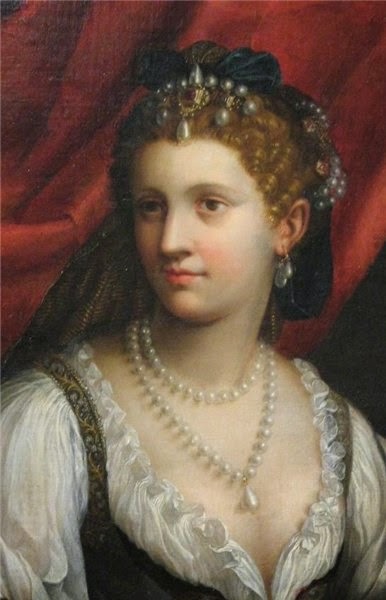
Fede Galizia
Pintora italiana, 1578-1630. Fede Gallizia, mejor conocida como Galizia, nació en Milán en 1578. Su padre, Nunzio Galizia, quien se mudó a Milán desde Trento fue un pintor de miniaturas. De él aprendió Fede a pintar, y se dice que a la edad de doce años era suficientemente considerada artista como para ser mencionada por Giovanni Paolo Lomazzo, pintor y teórico del arte amigo de su padre, de la siguiente forma: «Esta joven se ha dedicado a imitar a nuestros más extraordinarios artistas».
Como hija de Nunzio Galizia, pintor de retratos, Fede Galizia fue un artista consumada a la edad de doce años. Enseñada por su padre, Fede tenía un gran ojo para los detalles y su habilidad para pintar ropa y joyas la convirtió en una retratista muy popular.
Además de los retratos, también le encargaron pinturas religiosas y seculares, y pintó varias representaciones de Judith y Holofernes. Fede. También estaba interesada en los bodegones, por lo que quizás sea más conocida. Fue pionera en el género para mujeres y su estilo ha influido en la evolución de la pintura de bodegones.
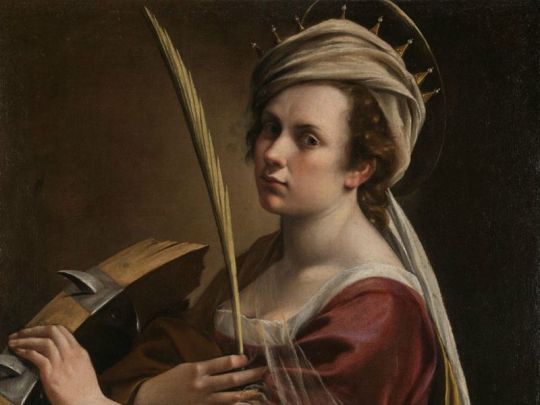
Artemisia Gentileschi
Pintora italiana, 1593-1652. Artemesia Gentileschi, la hija de Orazio Gentileschi, fue una de las artistas mujeres más reconocidas en el Renacimiento. Después de su muerte, la mayoría de las obras de Artemesia se atribuyeron a su padre y otros artistas hasta hace poco. Desde la reaparición de su obra y su historia, ha habido muchos estudios feministas de sus pinturas.
Fue entrenada por su padre, pero fue rechazada de las academias por su género. Luego continuó sus estudios bajo Agostino Tassi. Tassi violó a Artemesia y su padre posteriormente presentó cargos, lo que llevó a un juicio de siete meses durante el cual se le exigió que prestara testimonio bajo tortura. Tassi fue declarado culpable y Artemisia fue reivindicada, y se casó con el artista Pierantonio Stiattesi poco después.
Se dice que el trauma del acoso sexual y el asalto que ella experimentó aparece en sus obras. Estas incluyen varias descripciones de las violentas historias de Judith y Holofernes y Jael y Sisera, así como versiones de Susanna y los ancianos en las que Susanna exhibe terror genuino.
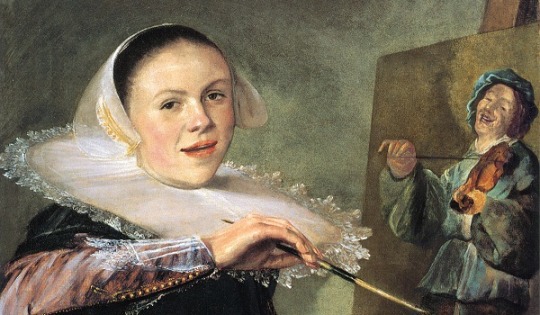
Judith Leyster
Pintora de la Edad de Oro holandesa. Pintó obras de género, retratos y naturalezas muertas. Toda su obra se atribuyó a Frans Hals o a su marido, Jan Miense Molenaer, hasta 1893, cuando Hofstede de Groot le atribuyó siete pinturas, seis de las cuales están firmadas con su monograma distintivo “JL”. La mala atribución de sus obras a Molenaer puede haber sido porque después de su muerte muchas de sus pinturas fueron inventariadas como “la esposa de Molenaer”, no como Judith Leyster.
Existen especulaciones sobre el hecho de que Leyster siguió una carrera en la pintura como resultado de la bancarrota de su padre y la necesidad de traer fondos para la familia. Ella pudo haber aprendido a pintar con Frans Pietersz de Grebber, que dirigía un taller respetado en Haarlem en la década de 1620. Durante este tiempo, su familia se mudó a la provincia de Utrecht, y ella pudo haber estado en contacto con algunos de los Carvaggisti de Utrecht.
Se especializó en escenas de género de retratos, comunmente, de una a tres figuras, que generalmente exudan buen ánimo y se muestran sobre un fondo liso. Muchos son niños, hombres con bebida, etc. Leyster fue particularmente innovadora en sus escenas de género domésticas. Estas son escenas tranquilas de mujeres en el hogar, a menudo con velas o lámparas, especialmente desde el punto de vista de una mujer.
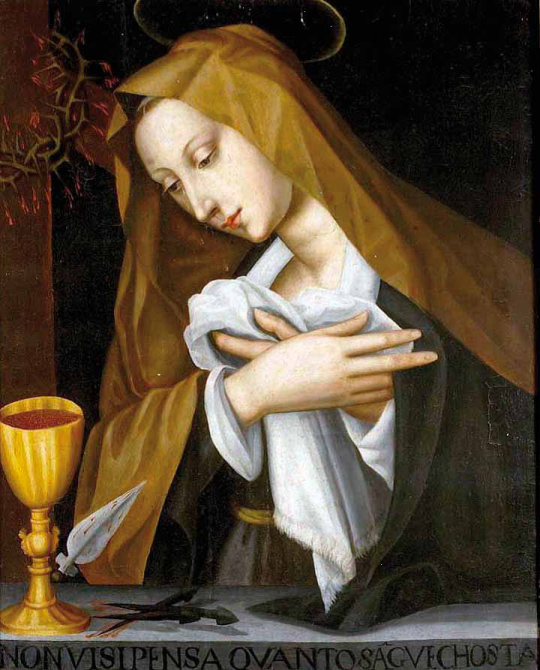
Plautilla Nelli
Sor Plautilla Nelli (1524–1588) fue una autora autodidacta, que era monja, y la primera pintora renacentista de Florencia, Italia. Pulisena Margherita Nelli nació en una familia adinerada en Florencia, Italia. Su padre, Piero di Luca Nelli, fue un exitoso comerciante de telas y sus antepasados se originaron en la zona del valle toscano de Mugello, al igual que la dinastía Medici.
Las predicaciones de Savonarola promovieron la pintura devocional y el dibujo de mujeres religiosas para evitar la pereza, por lo que el convento al que Nelli pertenecía se convirtió en un centro para monjas-artistas. Su hermana, también monja, Costanza, (Suor Petronilla) escribió una vida de Savonarola.
Aunque autodidacta, copió las obras del pintor manierista Agnolo Bronzino y del pintor renacentista Andrea del Sarto. Su principal fuente de inspiración fue la copia de obras de Fra Bartolomeo, que reflejaba el estilo de clasicismo impuesto por las teorías artísticas de Savonarola. Fray Bartolomeo dejó sus dibujos a su alumno, Fray Paolino, quien a su vez los dejó en posesión de “una monja que pinta” en el convento de Santa Caterina da Siena.
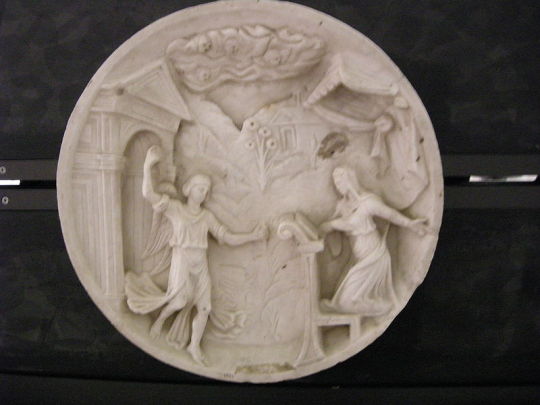
Properzia de Rossi
Properzia de Rossi nació en 1490, en Bolonia, Italia. Fue una de las pocas escultoras que se destacó tanto que Giorgio Vasari la incluyó en su famoso libro “Las Vidas de los Mejores Arquitectos, Pintores y Escultores Italianos”, de 1550. Properzia fue la única mujer escultora de su tiempo.
Era hija de un notario Girolamo Rossi. Sus padres supieron apreciar a una edad temprana el talento de su hija. La joven tuvo la oportunidad de aprender dibujo con grabador Marcoantonio Raimondi, donde se formó con pequeños bajorrelieves. Su pertenencia a una familia boloñesa medianamente poderosa le permitió dedicarse a las artes y acudir a la Universidad.
Su primer contacto con la escultura fue cuando realizó figuras en miniatura con los huesos de melocotones o albaricoques, tallándolos de forma esmerada y delicada, con gran detallismo. Estas piezas estaban consideradas como un objeto de lujo y eran muy solicitadas por la alta sociedad boloñesa. Esta forma de escultura va a hacerla muy popular, de modo que su fama comienza a ascender, comenzando a partir de 1520 a recibir encargos públicos.
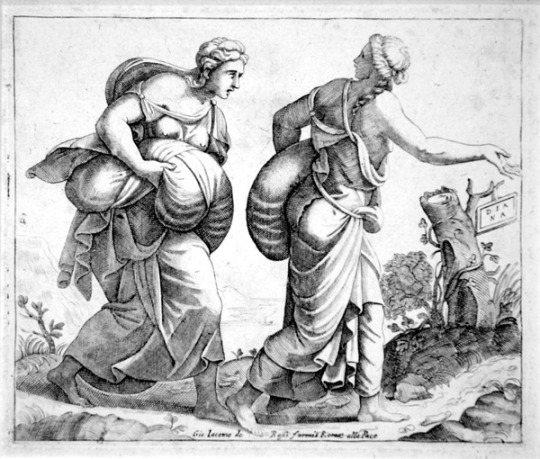
Diana Scultori
Diana Scultori (b.1535 dC) fue una grabadora italiana de Mantua, Italia. Es una de las primeras grabadoras conocidas. Después de su matrimonio en 1575 con el arquitecto aspirante Francesco da Volterra, la pareja se mudó a Roma. Aquí, el enfoque de su trabajo fue reinterpretar obras de artistas vinculados a su esposo y los talleres papales.
Fue una de los cuatro hijos del escultor y grabador Giovanni Battista Ghisi. Diana aprendió el arte del grabado de su padre y del artista Giulio Romano.
La mayoría de las impresiones se hicieron para promover y apoyar su carrera como arquitecto. Fue considerada una mujer de negocios muy interesada, y una de las pocas mujeres artistas a quienes Vasari mencionó en la edición de 1568 de sus Vidas. Trabajó dentro de las restricciones que encontraron los artistas de su época, mujeres o no. Utilizó el trabajo de otros artistas como base para sus grabados, pero la mayoría de los dibujos de sus grabados procedían de su esposo, un miembro de la familia, incluido su padre, o un artista.
Imagen 1: La Nascita di Venere, Sandro Botticelli, pintura sobre lienzo, 1485 – 1486
Imagen 2: Autorretrato, Levina Teerlinc, pintura sobre lienzo, 1560-1565
Imagen 3: Autorretrato, Caterina van Hemessen, pintura sobre lienzo, 1548
Imagen 4: Autorretrato, Sofonisba Anguissola , óleo sobre lienzo, 1554
Imagen 5: Autorretrato, Lavinia Fontana , pintura sobre lienzo, 1580
Imagen 6: Judit con la cabeza de Holofernes, autorretrato, Fede Gallizia , óleo sobre tela, 1610
Imagen 7: Autorretrato como Santa Catherina, Artemesia Gentileschi , óleo sobre lienzo, 1616
Imagen 8: Autorretrato, Judith Leyster , pintura al aceite, 1633
Imagen 9: Virgen dolida, Sor Plautilla Nelli , óleo, no datado.
Imagen 10: José y la esposa de Potifar, Properzia de Rossi, bajorrelieve sobre mármol
Imagen 11: Diana Scultori, grabado.
0 notes
Text

Saint Catherine of Siena/Beata Caterina de’ Ricci (c. 1560–c80), Suor Plautilla Nelli. Museo di San Marco, Florence. Photo: Advancing Women Artists.
#Saint Catherine of Siena#Plautilla Nelli#sister Plautilla Nelli#art by women#art#palianshow#women's art#art herstory#women painters
1 note
·
View note
Photo

Suor Plautilla Nelli, “Lamentation with Saints,” 16th century.
1 note
·
View note
Photo



Landmark Exhibition Looking at Work of Plautilla Nelli Extended to 4 June; Crowdfunding Campaign ends 16 April
As part of the push to showcase the works of women artists, the Galleria degli Uffizi launched an exhibition 8 March 2017 on the work of Suor Plautilla Nelli, one of the first documented female artists of the Renaissance. The show has been very well received, so much so that the exhibition is now slated to run until 4 June. Coinciding with the exhibition, sponsored in part by the Advancing Women Artists (AWA) Foundation, a crowdfunding effort has been launched to which supporters can donate through 16 April.
Alexandra Korey, representative of The FirstLast, the organizer of the fundraiser, shared the following release that suggests that the raised funds will be used to support ongoing restoration and conservation work for Nelli’s compositions:
“Plautilla Nelli's 191-pound canvas of The Last Supper needed six men to hoist it through the window and into the conservation studio, but the real 'window' on Nelli has opened during AWA’s campaign to involve the art-loving public in the restoration of this masterwork. In the last 40 days, Nelli has gone from being a virtually ‘invisible artist’ to being featured in 86 international newspapers, blogs, websites and magazines, thanks largely to TheFirstLast and the artist’s much-awaited Uffizi debut. The crowdfunding campaign ends on April 16 (Easter Sunday) whilst Nelli’s solo show will continue at Florence’s famed gallery until June 4.
And what would Girolamo Savonarola (who lit the first match on the Bonfire of the Vanities) think about Nelli’s recent appearance in Vanity Fair? For though the fire-and-brimstone Dominican preached in favor of art by convent women, he would likely be scandalized by the recent attention being showered upon the sixteenth-century nun who painted some of the Renaissance’s most precious works by a female artist. Several best-selling Tuscan-inspired authors from England, Canada and the United States, like Ross King, Dianne Hales and Sarah Dunant have come out in support of Nelli's Last Supper, in addition to Italian actress Elena Sofia Ricci. And so far, 322 people from 14 countries (Australia, Brazil, Canada, Finland, France, Germany, Ireland, Italy, Netherlands, New Zealand, Philippines, United Kingdom, USA, United Arab Emirates) have contributed to crowdfunding campaign, allowing the Foundation to reach 72% of our total goal so far.
A surge of support is expected for the Final Week, but other good news has stemmed from TheFirstLast, which has proved an authentic awareness-raising enterprise, shedding light on the need to salvage the over 2,500 works by women in the Florence museums and storehouses, starting with the largest work in the world by an early women artists—this 21-foot signed Last Supper, the only work of its kind anywhere. The project’s overwhelming participation has inspired AWA Board Member Cay Fortune to create an ‘Adopt an Apostle Program’ for each of the painting’s 13 figures and she then went on to personally ‘adopt’ Saint John for 10,000 dollars. The youngest saint is now ‘taken’ but the other twelve are waiting to be claimed! These funds will serve to complete elements of the conservation project not covered by the crowdfunding and to underwrite the book and AWA documentary spotlighting recent discoveries. The ‘Adopt and Apostle program’ is especially significant because, as yet, not all of the Saints at Nelli’s Last Supper table have been assigned their proper names. Part of the restoration process involves in-depth research with Museum curators, conservator Rossella Lari and the Dominican friars of Santa Maria Novella to discover the iconography and stories behind each of the painting’s characters. Sponsors and the art-loving public will discover ‘who is who’ first hand, as the restoration continues.
The recent hubbub about Nelli and her work has inspired La Effe, an Italian channel broadcast on Sky, to feature AWA and Florence’s first female painter in one of the six episodes of the series ‘Noi siamo Cultura’ (We Are Culture) directed by Giuseppe Carrieri and produced by Natia Docufilm, in collaboration with the Toscana Film Commission.”
Donors can contribute to the fundraised until Sunday, 16 April; those interested in donating can do so here.
The Last Supper, 16th century. Basilica of Santa Maria Novella, Florence.
Restoration work being executed on The Last Supper, which measures more than six meters in length (photograph courtesy of The Florentine).
Pained Madonna, 16th century. Museum of the Cenacolo of Andrea del Sarto, Florence.
#plautilla nelli#renaissance painting#women artists#florence#exhibitions#uffizi#awa#foundation#advancing women artists#last supper#art conservation#@awa_foundation
28 notes
·
View notes
Text
sede: Uffizi, Galleria delle Statue e delle Pitture (Firenze); cura: Fausta Navarro.
Alle donne artiste, e in particolare alle donne che coltivarono il loro talento creativo tra le mura conventuali, gli studi hanno dedicato crescente attenzione, specie negli ultimi vent’anni.
Anche la figura di Plautilla Nelli (Firenze 1524-1588), la “prima pittrice fiorentina” le cui opere ai tempi di Giorgio Vasari erano disseminate nei conventi e nelle dimore dei gentiluomini fiorentini, è stata investita dall’impulso dei nuovi studi. Per tale motivo le Gallerie degli Uffizi hanno voluto inaugurare la serie di mostre dedicate alle donne artista con una monografica sulla suora pittrice.
Entrata a quattordici anni nel convento domenicano di Santa Caterina in Cafaggio – a Firenze, in piazza San Marco -, Plautilla, imbevuta della mistica savonaroliana, fu interprete appassionata della poetica figurativa ispirata al magistero di Girolamo Savonarola nel campo delle arti e al nuovo modello disciplinato di santità femminile della riforma tridentina.
Nel monastero fiorentino ricoprì la carica di priora e fu a capo di una fiorente bottega artistica grazie alla quale numerose consorelle sue discepole contribuirono alla diffusione di immagini sacre, avvalendosi di una tecnica pittorica da vere professioniste. Intesa come parte integrante del lavoro quotidiano delle suore e approvato come regola di tutte le terziarie domenicane, la creazione di immagini sacre era valutata essenzialmente per la loro efficacia devozionale e non certo dal punto di vista dell’originalità dello stile o della composizione. Il gusto “conservatore” nel campo artistico delle suore – e di Plautilla Nelli in particolare – rifletteva la scala dei valori maggiormente stimati, tra cui al sommo grado quelli che rappresentavano la continuità della illustre tradizione artistica domenicana.
L’attività artistica del convento di Santa Caterina in Cafaggio fu destinata a soddisfare principalmente la richiesta del mercato dei “parenti e clienti”, ovvero di coloro i quali erano legati alla vasta rete dei conventi toscani dell’Ordine dei Predicatori. La richiesta era diffusa a tal segno da implicare la serialità, come nel caso dei quattro dipinti raffiguranti l’immagine di una santa domenicana ritratta di profilo che costituiscono il fulcro di tutta la mostra.
La vendita di tali opere divenne poi fondamentale per la vita del convento di Santa Caterina all’indomani della riforma dei monasteri femminili emanata dai decreti tridentini (1566), riforma che sanciva la proibizione di ricercare beneficenze fuori delle mura conventuali.
Le modifiche apportate alle iscrizioni che riportano il nome di santa Caterina da Siena distinguibili nella serie dei quattro dipinti tramandano il nome di “un’altra Caterina”: suor Caterina de’ Ricci, coetanea di Plautilla e anch’ella fervente savonaroliana, suggerendo la possibilità che in tali ritratti la Nelli volesse rappresentare la “monaca santa” di Prato, uguagliandola alla santa senese.
Finalmente è giunto il tempo che a Plautilla si dedichi una mostra, il tempo di riscattare la sua memoria storica e le sue opere d’arte spesso, ingiustamente, assegnate a uomini artisti: una mostra questa di Plautilla che apre la serie delle iniziative che le Gallerie degli Uffizi hanno in programma di realizzare ogni anno dedicate all’altra metà del cielo, alle donne che seppero distinguersi anche nel campo delle arti.
#gallery-0-4 { margin: auto; } #gallery-0-4 .gallery-item { float: left; margin-top: 10px; text-align: center; width: 25%; } #gallery-0-4 img { border: 2px solid #cfcfcf; } #gallery-0-4 .gallery-caption { margin-left: 0; } /* see gallery_shortcode() in wp-includes/media.php */
Plautilla Nelli. Arte e devozione in convento sulle orme di Savonarola sede: Uffizi, Galleria delle Statue e delle Pitture (Firenze); cura: Fausta Navarro. Alle donne artiste, e in particolare alle donne che coltivarono il loro talento creativo tra le mura conventuali, gli studi hanno dedicato crescente attenzione, specie negli ultimi vent'anni.
0 notes
Photo

Plautilla Nelli, la prima pittrice fiorentina COMMUNITY ARTISTICA CULTURALE "IL NOSTRO IMMENSO PATRIMONIO ARTISTICO CULTURALE"Google+ INVITO in Allegati:FINO 16 APRILE 2017 CAMPAGNA A FAVORE PER IL RESTAURO DELL'"ULTIMA CENA" 1570 di SUOR PLAUTILLA NELLI nota come POLISSENA DE'NELLI(1524 +1588)L'UNICA DIPINTA DALLA PRIMA PITTRICE FIORENTINA GRAZIE pittrice Susanna Galbarini ARTE.IT online MAPPARE L'ARTE IN ITALIA notizie e informazioni d'Arte con scheda personale profilo: www.arte.it/profilo.php
0 notes
Text
Attack Near Louvre Thwarted by French Soldiers—and the 9 Other Biggest News Stories This Week
Catch up on the latest art news with our rundown of the 10 stories you need to know this week.
01 A French soldier shot a man armed with a knife near Paris’s Louvre Museum on Friday morning.
(via the New York Times)
The man, who police said attempted to assault four soldiers with a knife while shouting “God is Great” in Arabic, was shot five times during the attack. One soldier suffered a minor scalp injury. The attacker was taken into custody and is being treated in for “life-threatening injuries,” according to a separate report in the Wall Street Journal. The attack took place in the Carrousel du Louvre, a shopping center that connects to an entrance to the world-famous museum. Some 250 visitors to the museum were moved to secure areas. Those who were visiting the shopping area and the museum who were taken to blocked-off areas were let out by midday. The museum closed for the rest of Friday but is expected to open again on Saturday, according to the Times. Recent terror attacks in Paris have been linked to a decline in attendance to the institution.
02 President Trump’s visa ban has had an immediate impact on artists and institutions.
(via the New York Times)
On Friday, Trump signed an executive order on immigration that restricts entry to the U.S. by citizens of seven majority-Muslim countries (Iran, Iraq, Libya, Somalia, Sudan, Syria, and Yemen) for 90 days, as well as prohibiting refugee entry for 120 days, with Syrian refugees indefinitely banned. The order has prompted protest and confusion across the world, as well as worry from artists and institutions. New York’s Metropolitan Museum of Art has expressed fears related to loans and travel, as well as an archaeological project the museum is working toward in partnership with Iraq and Iran. The Los Angeles County Museum of Art believes the new travel restrictions will affect an upcoming exhibition of art primarily from Iran. Many artists, some of whom hail from the countries affected by the ban, will forfeit international travel in protest of or due to the restrictions. Among them are Asghar Farhadi, the Iranian director of the Academy Award-nominated film “The Salesman,” who will not be attending the Oscars ceremony. (The director told the New York Times on Sunday that he’d skip the ceremony even if a travel exception were granted, in opposition.) Meanwhile, a green card-holding Iranian artist, Shahpour Pouyan, is unable to leave his home base in New York to travel to upcoming exhibitions in Toronto and Paris. The Museum of Modern Art in New York even went so far as to re-hang several of its galleries to highlight artists from the countries impacted by the travel ban.
03 The trial of the so-called “spider-man” burglar, who stole €100 million in artworks from the Musée d’Art Moderne, is underway in Paris.
(Artsy)
Vjeran Tomic is charged with stealing cultural property and, given he has a prior record, faces 20 years in prison if convicted. His two alleged accomplices face 10-year sentences if convicted on charges receiving stolen goods. In 2010, five works of art—valued at €100 million and often described as priceless—were stolen from Paris’s Musée d’Art Moderne. The thief eluded security systems and dozing security guards. Works by Picasso, Léger, Braque, Matisse, and Modigliani were carefully removed from their frames and vanished into the night. At the time, the city’s mayor Bertrand Delanoë called it an “an intolerable attack on the universal cultural heritage of Paris.” Now, six years later, the burglar, nicknamed “the spider-man,” and two accomplices are on trial. One of those accomplices says he panicked after the robbery and threw the works of art into the trash—though the presiding judge and his co-defendants don’t believe the claim. A verdict is expected on February 20th.
04 Sotheby’s has appointed Lord Harry Dalmeny as its U.K. Chairman.
(via Sotheby’s)
The 26-year veteran of the auction house fills the post, which has been vacant since James Stourton left Sotheby’s in 2012. He will now helm all of the house’s activities and strategy in the U.K. and Ireland. CEO Tad Smith called Lord Dalmeny “one of those remarkable forces of nature” and “a master on the rostrum” in announcing the 49-year-old’s promotion. Sotheby’s commended Lord Dalmeny’s skill in securing single-owner sales, connecting this acumen to his earliest experience at Sotheby’s in 1977, when the house sold his family possessions after the death of his grandmother. The move is somewhat of a departure from Smith’s recent hiring strategy for the U.S. arm of Sotheby’s, which has seen focus shift from the traditionally aristocratic business of auctioneering to recruiting individuals from the business and finance sectors, amidst moves for the house to increase its service offering to its clients, alongside its role as an auctioneer.
05 Florence’s Uffizi Gallery will exhibit more works by female artists.
(via The Art Newspaper)
The world-famous museum, known for its collection of works by Italian artists such as Botticelli, Michelangelo, and Leonardo da Vinci, is also home to “arguably the largest collection of [works by] female artists before the 19th century,” Eike Schmidt, the museum’s German-born director, told The Art Newspaper. The effort to exhibit more women stemmed from a 2015 conversation between Schmidt and the feminist collective The Guerrilla Girls, who have been waging a decades-long battle against the underrepresentation of women in the art world. Schmidt said the museum plans to make women artists more prominent, both in its permanent displays and through regular exhibitions at the Uffizi and the nearby Pitti Palace, of which Schmidt is also director. “This is not just a special initiative to do for three or five years. I don’t know if I’m still going to be director, but I think we could easily go on for 20 years,” he said. The effort kicks off with a show of paintings by Renaissance nun Suor Plautilla Nelli, scheduled to open on March 8th, International Women’s Day.
06 In a last-minute reversal, Israel will not join the EU’s culture program Creative Europe, which would have boycotted funding artists outside the country’s 1967 borders.
(via Haaretz)
Miri Regev, Israel’s controversial right-wing Minister of Culture and Sport, announced that she would be withdrawing her support for joining Creative Europe after it was revealed that the program would implement a boycott on funding for artists living in the Israeli occupied West Bank, East Jerusalem, and Golan Heights. Instead, funding would only be distributed within the country’s 1967 borders. Prime Minister Benjamin Netanyahu was to present the Creative Europe proposal to a cabinet meeting on Sunday but that plan has since been dropped by Regev. “I do not have to pursue anything that I do not agree with. Any international agreement with Israel must include the West Bank,” she said. The position is broadly in line with the conservative Israeli government, which has announced further settlements in the West Bank following the election of Donald Trump. But the move is a blow to Israel’s cultural sector, as Creative Europe would have allowed artists from within the country to apply for EU arts grants
07 Public funding for the arts will continue in Mississippi after bills aiming to dissolve the state’s arts commission died on Tuesday.
(via The Oxford Eagle/The Associated Press)
Republican lawmakers had sought to dissolve the commission as a stand-alone agency and merge its functions with the Mississippi Development Authority, in a stated effort to increase efficiency. Officials at the MAC were surprised at the news, Hyperallergic reported, not least because the agency already works closely with the MDA. The pair of proposed bills in the state’s legislature failed to be debated by House and Senate committees before Tuesday’s deadline for consideration. After the bills failed, Democratic state representative Jay Hughes said, “It was a terrible idea to put politicians in charge of one of the few things that Mississippi does right.” The attempt came amidst a broader national discussion around arts funding, following a report that President Donald Trump is considering eliminating the National Endowment for the Arts. As Artsy has reported, curbing the NEA’s small budget could have outsized repercussions for the institutions across the country that rely on it, and could in fact dampen economic growth.
08 Amid fears a Madrid museum could lose over 400 works from a major collection, a temporary loan agreement has been reached.
(via The Art Newspaper & artnet News)
Earlier this week it was reported that the works, by artists including Monet, Rodin, Matisse, and Picasso, could enter limbo after the Museo Thyssen-Bornemisza museum failed to reach a new loan agreement with its owner, Baroness Carmen Cervera. The widow of an industrial tycoon, Cervera wanted a new contract that would allow her to loan works from the collection—valued at €750 million—to other museums within Spain and internationally. Cervera previously attempted to sell the collection to the Spanish state, though was ultimately unsuccessful. A six-month loan extension was signed in 2016, and expired on Monday; officials have drafted another extension for three months, during which time a longer lasting agreement will hopefully be negotiated. The dispute even attracted the involvement of Spanish government, with the Minister of Education, Sport, and Culture helping to negotiate the settlement.
09 A key player in the $80 million Knoedler forgery scandal will face no jail time, a judge ruled Tuesday.
(via Reuters)
Glafira Rosales, a Long Island art dealer implicated in the massive forgery ring that rocked the art world and brought down New York gallery Knoedler & Company in 2011, will not be sent to prison. Instead, she was sentenced to nine months of house arrest by U.S. District Judge Katherine Polk Failla. This follows a 2013 confession from Rosales to, among other charges, conspiracy, wire fraud, money laundering, and filing false tax returns in relation to her role in helping two Manhattan galleries buy dozens of fake paintings, which they then sold for tens of millions of dollars. In letting Rosales off without prison time, Failla cited Rosales’s contention that she attempted to back out of the illegal scheme several times, only to be forced to continue by an abusive former boyfriend, Jose Diaz. Thus far, Rosales is the only one of the four defendants in the case to have been sentenced. The actual artist behind the forgeries, Pei-Shen Qian, is currently a fugitive believed to be in China. Diaz and his brother were both arrested in Spain in 2014 in relation to the case, but an extradition request by the U.S. government was denied.
10 New York’s Vilcek Foundation has named the winners of the 2017 Vilcek Prizes, which honor the contributions of immigrant artists.
(via Vilcek Foundation)
Jamaica-born Nari Ward, who moved to the U.S. at the age of 12, was named as the recipient of the Vilcek Prize for the Arts. He was selected for the sizeable award of $100,000 by a jury including Prospect New Orleans executive director Brooke Davis Anderson, the New Museum’s Massimiliano Gioni, and the Guggenheim’s Sara Raza. Three younger artists—Iman Issa, Meleko Mokgosi, and Carlos Motta—were each selected to receive Vilcek Prizes for Creative Promise in the Fine Arts. Each will receive $50,000 in cash in recognition of their selection. The foundation and awards are endowed by Jan and Marica Vilcek, immigrants to New York from the former Czechoslovakia. Coming less than one week after President Donald Trump’s executive order temporarily barring immigration from seven predominantly Muslim countries, the Vilcek Prizes command particular resonance this year, in their mission to honor the cultural contributions of those who have come from abroad and chosen to make America their home.
—Artsy Editors
Cover image: Photo by Wally Gobetz, via Flickr.
from Artsy News
0 notes